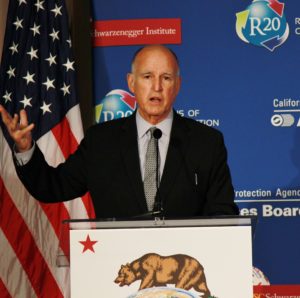California’s Cap and Trade Extended
 The extension of California’s Cap and Trade program through AB 398 is a big win for California, and for Californians. California’s cap-and-trade program uses a market-based mechanism to lower greenhouse gas emissions. Now the program will be extended through 2030, a major means to fulfill the State’s commitment to lower greenhouse gas emissions by 40% below 1990 levels by 2030.
The extension of California’s Cap and Trade program through AB 398 is a big win for California, and for Californians. California’s cap-and-trade program uses a market-based mechanism to lower greenhouse gas emissions. Now the program will be extended through 2030, a major means to fulfill the State’s commitment to lower greenhouse gas emissions by 40% below 1990 levels by 2030.
California’s Cap-and-Trade rules came into effect on January 1, 2013 and have applied to large electric power plants and large industrial plants. In 2015, the rules were extended to distributors of heating and transportation fuels. Then, the program encompassed ~ 360 California businesses and nearly 85% of the state’s total greenhouse gas emissions. In January 2014, California’s program was linked to Québec’s program.
Under a cap-and-trade system, companies must hold enough emission allowances to cover their emissions. They are free to buy and sell allowances. California held its first auction of greenhouse gas allowances on November 14, 2012.
While the market mechanism makes sense, it has been fraught with challenges. One of the biggest is who gets the money generated. Everyone wants it. The Governor has been pushing for its use to fund California’s High Speed Rail project. Other fight for EJ… environmental justice… and using Cap and Trade revenues to offset years of local air pollution, for instance communities bisected by highways and homes close to industry.
Perhaps the most remarkable aspect of the bill’s passage was its bipartisan nature. May it be a lesson to Washington. Assembly Republican Leader Mayes spent months expressing interest in negotiating with Gov. Jerry Brown and other Democrats on an extension of cap-and-trade, the state’s signature climate change program.
After helping to secure a number of amendments that would make the law more amenable to the industries most directly affected by its regulations, and possibly give Republicans more of a say in how revenues are spent, Mayes delivered seven critical votes that pushed it over a necessary two-thirds threshold in the Assembly. Apparently a wave of conservative backlash since the vote could cost him his post as head of the Assembly’s 25-member GOP caucus.
The Governor signed the legislation on Treasure Island, the same location where Governor Arnold Schwarzenegger signed AB 32 (the California Global Warming Solutions Act of 2006), which authorized the state’s cap-and-trade program more than a decade ago. AB 398 strengthens and extends the state’s cap-and-trade program, which would have expired without legislative action. According to experts, it also enhances the original legislation: It cuts the use of out-of-state carbon offsets and brings those environmental benefits back to California. It prioritizes cap-and-trade spending to ensure funds go where they are needed most, including reducing diesel emissions in the most impacted communities. And its companion bill, AB 617 makes provisions to reduce air contaminants in California’s most polluted cities.
Extending California’s cap-and-trade program ensures that billions of dollars in auction proceeds continue flowing to communities across California. To date, these investments have preserved and restored tens of thousands of acres of open space, helped plant thousands of new trees, funded 30,000 energy efficiency improvements in homes, expanded affordable housing, boosted public transit, and helped more than 100,000 Californians purchase zero-emission vehicles.
